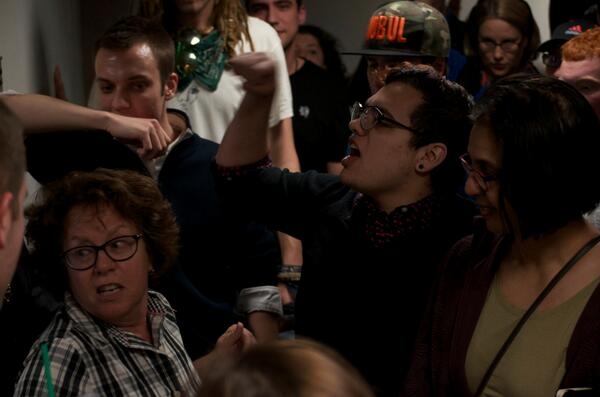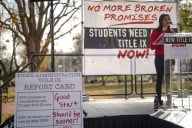You have /5 articles left.
Sign up for a free account or log in.

Students occupy hall outside the provost's office at U. of Southern Maine
Photograph by Justicia Barreiros for The USM Free Press
Anger over faculty layoffs at the University of Southern Maine boiled over Friday when about 100 people, led by students, protested outside the provost’s office, trying to prevent and protest meetings he scheduled to tell professors they were losing their jobs.
The cuts were recently announced and are part of a broader attempt to restructure the 6,000-student university in Portland. The university is trying to shed 30 faculty jobs through layoffs and retirements.
The plan to lay off a dozen liberal arts faculty members on Friday prompted students along with some faculty and staff to occupy a hall outside Southern Maine’s administrative suite, a move that kept Provost Michael Stevenson in his office. Stevenson was able to do some layoffs in person as professors came to the scheduled meetings; others he did by email, according to one professor.
Southern Maine is not alone in its woes. It and six other institutions in the University of Maine System are planning to lay off about 165 faculty and staff members this year, according to the system’s central office. Since 2007, the seven universities have gotten rid of 520 positions, including a tenth of the faculty, a quarter of the administrators and about a sixth of the hourly employees.
The tension at Southern Maine became acute, though, and faculty have accused the administration there of making cuts needlessly and somewhat manipulatively by attempting to pit junior and senior professors against each other. The effect, faculty critics say, has been an attack on tenure.
At least at Southern Maine, the brunt of faculty cuts this year seem to be falling on liberal arts professors. The dozen layoffs on Friday included professors in arts, economics, English, philosophy, sociology, theater, music, public policy and honors programs, President Theodora Kalikow said in an email to the campus.
The university has 310 full-time faculty instructors. The president said her goal is to reduce that to 280 in this round of layoffs, which puts professors out of work at the end of May. Up to 34 staff jobs are also being eliminated.
“We are at a point where the number of faculty positions needs to be adjusted so that we can continue to deliver a high-quality education to a smaller student body,” Kalikow wrote.
Kalikow has blamed “less revenue, higher costs and intense competition for fewer students” for a $14 million “structural deficit.”
Professors in the liberal arts sharply questioned the direction of the university and the number of liberal arts professors getting the axe while business, nursing and non-liberal arts programs are mostly spared the cuts. “A university that doesn’t have a robust core of liberal arts isn’t a university, it’s a trade school,” said Susan Feiner, a professor of economics who is not being laid off.
Bob Caswell, a university spokesman, said that while the bulk of the recent layoffs are in the liberal arts college, the administration believes arts and humanities are still at the core of any education.
"I understand where the faculty are coming from," he said, "but in terms of claims we are trying to gut the arts and humanities -- I know it feels that way -- but it just isn't the case."
Demographic and Financial Shifts
Southern Maine and the whole Maine system are dealing with the demographic and financial struggles of other colleges across the country, said Rebecca Wyke, a system vice chancellor.
The system’s budget appropriation from the state is $6 million below where it was in 2008 and could get worse by millions more depending on how lawmakers settle this year’s budget, Wyke said. Besides that, tuition has been frozen for the past two years and will likely be frozen again this coming year. In the meantime, projections show the state will graduate a fifth fewer high school students by the end of the decade than at its beginning.
At Southern Maine, enrollment fell unexpectedly. The university, which has three campuses, had a budget for about 6,900 students last fall and about 6,500 this spring. Instead, only 6,500 came in the fall and 5,900 came in the spring, according to system data.
The passion that erupted on Friday seems to have been student-driven, and came in response to the dozen or so layoffs announced earlier this month, which came atop earlier layoffs associated with program closures announced earlier.
“I’m standing in solidarity with my fellow students and faculty who are obviously very upset with the administration for having to cut faculty positions,” student government president Kelsea Dunham said Friday in a phone call from the hallway outside the provost’s office where the protests were happening. She said she followed the lead of other students to begin the protests.
At one point, students tried to enter the provost's office with a professor who was abut to lose her job.
She’s not getting in without us, they said, according to several people present. But layoffs happened anyway.
"It was very emotional and understandably so," Caswell said. "On the other hand, it's good to see students care about the university and their educations."
He said Saturday that protestors had left, though it's possible they could resume their actions. Over the weekend, student government members voted they had no confidence in the Kalikow and her administration.
Young vs. Old?
Faculty complained that the administration’s way of going about the layoffs was manipulative and resulted in an attack on both tenure and senior professors. The administration had offered inducements to get some senior faculty to retire early. But when not enough decided to leave, junior faculty found out they were getting the axe and pressure emerged on senior faculty to leave and spare the younger faculty their jobs.
“They are really pitting old against new in a kind of social Darwinism,” said Christy Hammer, a sociology professor and president of the local chapter of the Associated Faculties of the University of Maine, an affiliate of the National Education Association.
Hammer said the method prompted infighting to break out within departments.
The "last hired, first fired" method is nothing new, but the faculty said that sort of thinking did not belong in nonprofit higher education.
“To my way of thinking, the administration is assaulting the whole institution of tenure,” said Rachel Bouvier, an economics professor who was laid off Friday.
Caswell, the university spokesman, said the order of layoffs was actually a product of the system's faculty contracts. Those contracts are negotiated by the union.
"Under terms of the faculty contract, those with less seniority are terminated before those with more seniority," he said in an email. "I also should add that the University of Maine System has an extensive and rigorous HR process in place to help ensure that age, gender and other forms of discrimination are NOT part of any personnel actions."
Bouvier, who earned tenure in 2011, said she didn’t think she would be in danger. She’s publishing, her student evaluations are high and the courses she teaches are required in the business program — which has been protected from layoffs, faculty said — and other popular majors.
But Bouvier was told Thursday to meet with the provost on Friday. Shortly after she spoke on the telephone with a reporter Friday afternoon, she went into the provost’s office and received a termination letter, effective the end of May.
John Baugher, a tenured associate professor of sociology, expressed a common sentiment among faculty critics: administrators are creating a crisis in order to eliminate the liberal arts and shift the university’s mission. But he was particularly taken aback by the pressure on senior liberal arts faculty to retire. So he volunteered to go, in hopes of saving someone else’s job.
The retire-or-fire tactic appears to have worked, in part. Kalikow announced that the number of layoffs scheduled for Friday had been reduced to 12 from 15 because of retirements.
Baugher argues that the administration is not showing much leadership. He said if the president and the provost both took 15 percent pay cuts, the savings could save one person’s job. And that move, he said, could inspire other faculty to take voluntary cuts to save other jobs.
Faculty dispute the numbers being used to justify the layoffs. Feiner, in a telephone interview and in a recent op-ed, said the system is sitting on money.
Wyke, the system’s top financial official, said the money that the system has is all tied up or set aside for things like guaranteeing the health plan for system employees. There is, she said, a $15 million rainy day fund, which has been accumulated over the years, but universities are asking for $9.8 million from that and if lawmakers make steeper cuts, it could be wiped out.
“We have that for the day it rains, and I think FY’15 is going to be it,” Wyke said, referring to the fiscal year that begins this summer.
In an email to several colleagues, Baugher, who is voluntarily leaving to try to save another professor’s job, said because of the job market he didn’t know if he would ever work at a university again. But he said he was choosing not to dwell on that because of “what is required of me right now.”
“We have known for a long time that there is no visionary leadership at this university, and instead the focus is solely on bean counting. Well,” Baugher said to his coworkers, “they have decided that some of the beans have got to go.”








